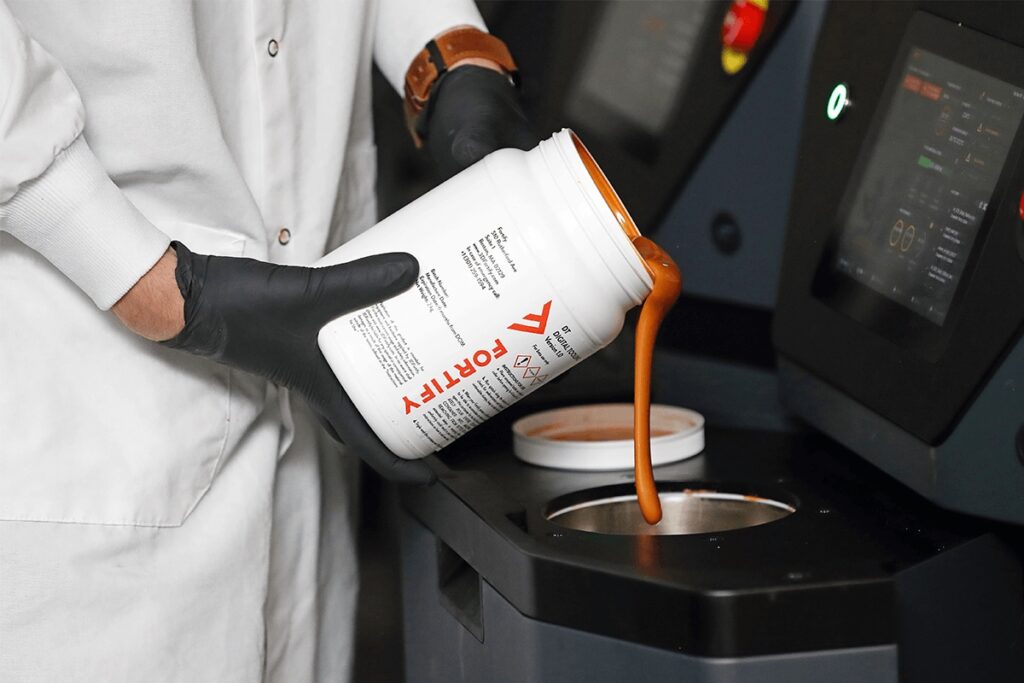Fortify, a Boston-based additive manufacturing (AM) company, announced that it has received $12.5 million in the latest round of funding for its Digital Composite Manufacturing (DCM) platform. Significantly, two of the investors include Lockheed Martin Ventures and RTX Ventures — the venture capital arm of Raytheon Technologies — marking the first time the two defense giants have collaborated on an investment.
Combining proprietary resin mixing and magnetic alignment of particles, Fortify’s DCM technology is a specialty version of digital light processing (DLP). The firm specializes in the R&D and supply of advanced composite materials, especially for radio frequency (RF) applications—hence why the company has already established such a strong foothold in the aerospace and defense market. Lockheed Martin Ventures made a previous investment in the startup at the end of last year, and a few months prior to that, so did the US intelligence community venture capital fund, In-Q-Tel.
These are also among the reasons why I included Fortify in my list of companies to watch in this post from a few months ago, about developing investing strategies by looking over the shoulder of the pillars of US heavy industry. In addition to defense, Fortify is plugged into the reservoir of public funding for energy projects, counting those from the Department of Energy (DOE) and Lawrence Livermore National Labs. Moreover, the firm has impressive backing from Silicon Valley, as well, with Accel, one of the world’s most influential venture capital funds, being an early Fortify investor.

In a press release announcing the $12.5 million funding round, Chris Moran, vice president and general manager of Lockheed Martin Ventures, commented, “Lockheed Martin Ventures’ continued investment in Fortify underpins the strategic advantage the company can bring to the defense industrial base. We believe Fortify has the potential to deliver tailored solutions not only to the aerospace and defense industry, but a range of sectors that can benefit from their platforms.”
Eric Wolford, a partner at Accel, said, “This investment from Lockheed Martin Ventures and RTX Ventures confirms the potential behind the Fortify technology platform. It is my understanding that this is the first time these two [aerospace and defense] giants have co-invested. So, this is a big win for the company and a strong validation.”

Following up on the last sentence from the above quote — it is “a strong validation” for the entire AM industry, insofar as it highlights the strategic priority that stakeholders are ascribing to the sector’s underlying technologies. If this is the first time that this pair of behemoths is coming together to invest in the same infrastructure, then (1) there must be a particularly compelling case for the necessity of that specific infrastructure, and (2) it is probably going to be the basis for further collaboration.
That also gets at the virtue of having the company led by someone like Lawrence Ganti, who worked on Operation Warp Speed, and who became the company’s CEO last November. It would probably be impossible to think of an example of more relevant job experience from recent history for coordinating the needs of a variety of public and private stakeholders into the rapid development of new technologies.
Finally, referring to the comment from the VP and GM of Lockheed Martin Ventures, it seems likely that there will be increasing cooperation between competitors on projects such as this one, the more that military contractors start to dip their toes into the waters of other sectors. Given the details of the debate surrounding the US debt ceiling, it is only a matter of time before other agencies start nibbling around the edges of the defense pie. Defense companies are nothing if not long-range planners, so they are simultaneously readying themselves for diversification at the same time as they’re pushing back against threats of limits to the defense budget’s growth.
Images courtesy of Fortify
Subscribe to Our Email Newsletter
Stay up-to-date on all the latest news from the 3D printing industry and receive information and offers from third party vendors.
You May Also Like
Gorilla Sports GE’s First 3D Printed Titanium Cast
How do you help a gorilla with a broken arm? Sounds like the start of a bad joke a zookeeper might tell, but it’s an actual dilemma recently faced by...
Nylon 3D Printed Parts Made More Functional with Coatings & Colors
Parts 3D printed from polyamide (PA, Nylon) 12 using powder bed fusion (PBF) are a mainstay in the additive manufacturing (AM) industry. While post-finishing processes have improved the porosity of...
$25M to Back Sintavia’s Largest Expansion of Metal 3D Printing Capacity Since 2019
Sintavia, the digital manufacturing company specializing in mission-critical parts for strategic sectors, announced a $25 million investment to increase its production capacity, the largest expansion to its operations since 2019....
Velo3D Initiates Public Offering in a Bid to Strengthen Financial Foundations and Drive Future Growth
Velo3D (NYSE: VLD) has been among a number of publicly traded 3D printing firms that have attempted to weather the current macroeconomic climate. After posting a challenging financial report for 2023,...































